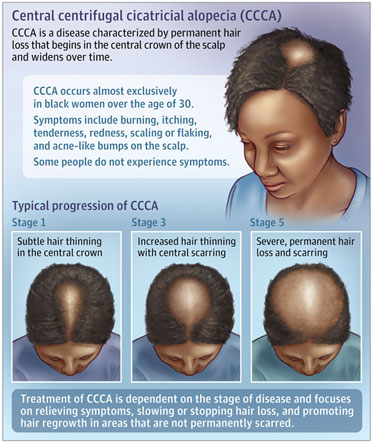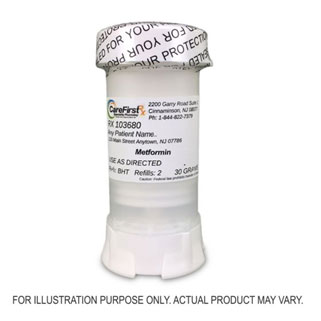Topical Metformin for Alopecia
Topical Metformin for Alopecia
What is Alopecia?
Alopecia, or hair loss, is a disorder caused by a disruption in the hair production cycle. There are several types of alopecia, such as androgenetic alopecia, telogen effluvium, anagen effluvium, alopecia aerata, cicatricial alopecia, etc. The most common type of hair loss is androgenetic alopecia, and this is what we normally know as pattern baldness. Since this is very common, there are many effective treatments available.
However, the rarer forms of alopecia, such as cicatricial alopecia, have few treatments available. Cicatricial alopecia, or scarring alopecia, is an inflammatory disorder. In this form, inflammation surrounds the hair follicle, causing damage and formation of scar tissue in place of the hair. The inflammation is typically at the stem cells and sebaceous glands, thus causing no further hair growth at that follicle. The main regulator behind this inflammation is considered to be PPAR gamma (peroxisome proliferator-activated receptor gamma). A decrease in this regulator causes dysfunction in the sebaceous glands, causing buildup of toxic lipids. These lipids are thought to be inflammatory, eventually destroying the follicles.
What is central centrifugal cicatricial alopecia (CCCA)?

This form of cicatricial alopecia is predominant in women of African descent The inflammation is typically progressive over time, which leads to fibrosis occurring at the damaged follicles. This alopecia presents with the breaking and thinning of hair in the crown area of the scalp, with symptoms of burning, itchiness, redness, and bumps at the hair follicles.
Treatment Options
Mild symptoms
- Topical steroids +/- local corticosteroid injections
Transition into severe symptoms
- Topical steroids + local corticosteroid injections + oral immunosuppressants
Metformin
Metformin is a widely used medication used to treat type 2 diabetes. It is also commonly used for polycystic ovary syndrome and hirsutism. It works by activating the enzyme AMPK (AMP kinase), which increases AMP levels and also has several downstream effects, such as improvement of insulin sensitivity via increased peripheral glucose uptake and reduction of circulating androgens. Androgens are known to cause an increase in hair growth. Since Metformin reduces androgen levels, it might negatively affect the overall progression of androgenetic alopecia, as hair growth would be decreased.
However, due to its mechanism of action, Metformin can be beneficial for CCCA. Patients with CCCA have been found to have downregulation (decrease) of certain genes, especially those involved in lipid metabolic pathways. Lipids are important for hair follicle growth and with CCCA, toxic lipid buildup occurs in the follicles, which can be attributed to problematic gene regulation. An important gene is PRKAA2 (protein kinase AMP-activated catalytic subunit alpha 2 gene), which encodes for the enzyme AMPK. Lower activity of AMPK has been found to be involved in fibrosis. Since Metformin activates AMPK, the enzyme can increase its activity and function appropriately. This mechanism was studied in mouse studies of lung fibrosis, in which Metformin was able to reverse fibrosis in a AMPK dependent manner. This finding further prompts the possible use of Metformin for CCCA.
Topical Metformin 10% for Alopecia
There have been a few published case reports supporting the use of topical Metformin for central centrifugal cicatricial alopecia
A 69 year old African American woman had progressive hair loss and confirmed stage 4a CCCA. She was treated with topical minoxidil (common hair loss medication), 8 cycles of triamcinolone injections, and topical clobetasol (corticosteroid). She continued this therapy for 5 years and decided to stop. She was then started on Metformin 10% topical cream, starting at 3 time per week and later increasing to once daily application. After 6 months, she has a substantial improvement in her hair growth.
A 54 year old African American woman had stage 4a CCCA, and was treated with 5 cycles of triamcinolone injections, minoxidil foam, ketoconazole cream, and clobetasol ointment. These treatments only provided minimal improvement. She continued minoxidil and triamcinolone injections, but also added Metformin 10% cream once daily to her treatment regimen. After 4 months, improvement was observed.
Since there are few effective treatment options for CCCA, topical Metformin might be beneficial for those patients who found little to no benefit with common alopecia treatments.
Where to get Topical Metformin 10% cream?
Most regular pharmacies will not have Metformin cream as it is commercially available in tablet form. Since the use of the Metformin for alopecia is still being studied, the cream form will only be available at specialty compounding pharmacies. These pharmacies are able to make patient specific medications that are not available at regular pharmacies. They have the ability to create and compound new formulations, such as creams, for off-label uses of commonly available medications.

References:
- Araoye EF, Thomas JAL, Aguh CU. Hair regrowth in 2 patients with recalcitrant centrifugal cicatricial alopecia after use of topical metformin. JAAD Case Rep. Feb 2020; 6(2): 106-108. https://www.ncbi.nlm.nih.gov/pmc/articles/PMC6992882/. Accessed Feb 14, 2021.
- Aguh CU, McMichael A. Central Centrifugal Cicatricial Alopecia. JAMA Dermatol. 2020;156(9):1036. doi:10.1001/jamadermatol.2020.1859
- Types of Hair Loss. nyulangone.org. https://nyulangone.org/conditions/hair-loss/types. Accessed Feb 14, 2021.
- Metformin. Lexi-Drugs. Lexicomp. Wolters Kluwer Health, Inc. Riverwoods, IL. Accessed Feb 14, 2021. http://online.lexi.com.
- Aguh C, Dina Y, Talbot CC, et al. Fibroproliferative genes are preferentially expressed in central centrifugal cicatricial alopecia. J Am Acad Dermatol. Nov 2018; 79(5): 904-912. https://www.ncbi.nlm.nih.gov/pmc/articles/PMC6348462/. Accessed February 22, 2021.



Comments